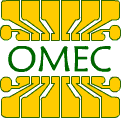Novel organic semiconductors
The Organic Materials in Electronics Consortium
Introduction
Rapid progress has been achieved in the development of organic semiconductors for use as the active layers in OLEDs, PLEDs, OFETs and photovoltaics. New materials are needed to tune the colour of the light emission, improve the device performance and the lifetime of the devices while maintaining the solution processability of these materials. OMEC is addressing this need by developing new families of materials for application in OFETs and organic photovoltaics.
Right: Part of the crystal structure of a cyclopentadithiophene monomer showing two closely packed stacks of molecules. These molecules have been designed so that the alkyl chain substituents are held in the same plane as the rings to assist close packing and improve carrier mobility. (Adjust the viewing angle to investigate the stack structure by moving your mouse over the image).
These include:
- Conjugated oligomers, including fused ring structures such as oligoacenes, indolocarbazoles, cyclopentadithiophenes.
- Conjugated oligomers with reactive end groups for surface attachment or in situ cross-linking.
- Amorphous polymers such as poly(triarylamines) and poly(cyclopentadithiophenes).
- Semicrystalline polymers based on fused ring thiophenes.
- Conjugated block copolymers based on phenylenevinylene, thiophene and carbazole repeating units.
In addition OMEC is developing new synthetic methodology to deliver:
- Chain growth polymerization reactions for conjugated polymers.
- Libraries of organic semiconductors to define structure-property-performance relationships.
The synthetic programme works closely with theoreticians, formulation scientists and device physicists to ensure that the materials are fit for use in OFETs, sensors or photovoltaic devices.

News